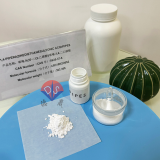Chinese VersionChina Suppliers > Hubei new DE sheng material science and technology co., LTD. > A detailed introduction to Good's buffer PIPES
- Search Product
-
-
- Region :China/Hubei
- Tel : +86-18971041571
- Fax :
- Email :vickyzhao@whdschem.com
- URL :
- Add :Guanggu United Science and Technology City C8, Ezhou City, Hubei Province
- Details for A detailed introduction to Good's buffer PIPES
-
A detailed introduction to Good's buffer PIPES
Category : Other Chemicals/Others

CAS NO : 5625-37-6 EC NO : 227-057-6 MF : C8H18N2O6S2 MW : 302.36 Specification : White Powder Packing : 500g/bottle Product description : PIPES (piperazine N, N ` di (2-ethanesulfonic acid)) is a zwitterionic buffer with a buffering pH range of 7.2-7.4. It is insoluble in water but soluble in sodium hydroxide aqueous solution. PIPES is included in Good's buffer and is widely used in vaccine production, tissue culture, cationic efficacy research, and separation techniques for biological substances. Basic introduction of PIPES buffer PIPES is different from other buffering agents, such as BIS-TRIS and BICINE, as it cannot form stable compounds with many metal ions, making it very suitable as a buffering agent in metal ion solutions. There are two pKa values for PIPES, namely 1pKa and 2.67pKa. 1pKa is 6.76 at ambient temperature of 25 ° C, close to physiological pH, with a buffer range of 6.1-7.5, which is suitable for cell culture work. 2.67pKa has a buffer range of 1.5-3.5 at 25 ° C. Where can PIPES be applied PIPES can be used to purify tubulin by cellulose phosphate chromatography and recombinant GTP by gel filtration, which can bind proteins ARF1 and ARF2 to crystallize transketolase from Escherichia coli as a buffer. However, it is worth noting that PIPES is not suitable for redox systems as it can form free radicals. The advantages of PIPES buffer 1. The fixation of glutaraldehyde in animal and plant tissue samples can lead to lipid loss with significant morphological changes. When using PIPES buffered glutaraldehyde fixative, lipid loss and artifacts are minimized. 2. If immobilized in oxalate buffered glutaraldehyde for supercellular chemical fixation, it is possible to selectively lose the activity of alkaline phosphatase. When using PIPES as a buffer, the activity retention rate will be significantly improved. 3. The combination of glutaraldehyde and formaldehyde in PIPES buffer can achieve excellent fixation of fungal spores under fluorescence and electron microscopy. Desheng Biochemical has been established for 17 years and has rich experience in the research, development, production, and sales of biological buffer solutions. As a professional manufacturer of biological buffering agents, Desheng can provide high-quality buffering agents and customize them according to the special requirements of customers. If you have such needs, you can click on the website to consult and purchase! Uses : Biological buffer Synonyms : PIPES, Free Acid, ULTROL Grade;2,2-(piperazine-1,4-diyl)bis(ethanesulphonic) acid;PIPES Piperazine-N,N-bis(2-ethanesulfonic acid);PIPES, Molecular Biology Grade Piperazine-N,N-bis(2-ethanesulfonic acid), Molecular Biology Grade;PIPES, Free Acid, MB Grade (1.12030);1,4-Piperazinebis(ethanesulfonic acid);Piperazine-1,4-bis(2-ethanesulfonic acid);Piperazine-N,N'-bis(2-ethanesulfonic acid);Piperazine-1,4-bisethanesulfonic acid;LABOTEST-BB LT00138111;1,4-PIPERAZINEDIETHANESULFONIC ACID;PIPERAZINE-NN'-BIS-2-ETHANESULPHONIC ACID;TIMTEC-BB SBB008973;PIPES; Molecular Structure : 
- more>>Other Products
-
- • Biological buffer 3- [N, N-di (hydroxyethyl) amino] -2-hydroxypropanesulfonic acid DIPSO
- • Luminol Sodium Salt
- • 4-Aminophthalhydrazide
- • acridinium ester DMAE-NHS
- • acridinium ester NSP-DMAE-NHS
- • Acridine hydrochloride NSP-SA
- • Acridine hydrochloride NSP-SA-NHS
- • NSP-SA-ADH
- • acridinium ester ME-DMAE-NHS TOOS; 3-(N-Ethyl-3-Methylanilino)-2-Hydroxypropanesulfonic Acid Sodium Salt
- • TOPS; Sodium 3-(N-Ethyl-3-Methylanilino)Propanesulfonate; N-Ethyl-N-Sulfopropyl-M-Toluidine Sodium Salt
- • ADOS Sodium 3-(Ethyl(3-Methoxyphenyl)Amino)-2-Hydroxypropane-1-Sulfonate Dihydrate
- • ADPS N-Ethyl-N-(3-Sulfopropyl)-3-Methoxyaniline Sodium Salt
- • ALPS N-Ethyl-N-(3-Sulfopropyl)Aniline Sodium Salt; Sodium 3-(Ethyl(Phenyl)Amino)Propane-1-Sulfonate; Sodium
- • DAOS; Sodium 3-((3,5-Dimethoxyphenyl)(Ethyl)Amino)-2-Hydroxypropane-1-Sulfonate
- • HDAOS; N-(2-Hydroxy-3-Sulfopropyl)-3,5-Dimethoxyaniline Sodium Salt
- • MADB N,N-Bis(4-Sulfobutyl)-3,5-Dimethylaniline Disodium Salt
- • MAOS N-Ethyl-N-(2-Hydroxy-3-Sulfopropyl)-3,5-Dimethylaniline Sodium Salt Monohydrate
- • DAB 3,3',4,4'-Biphenyltetramine Tetrahydrochloride